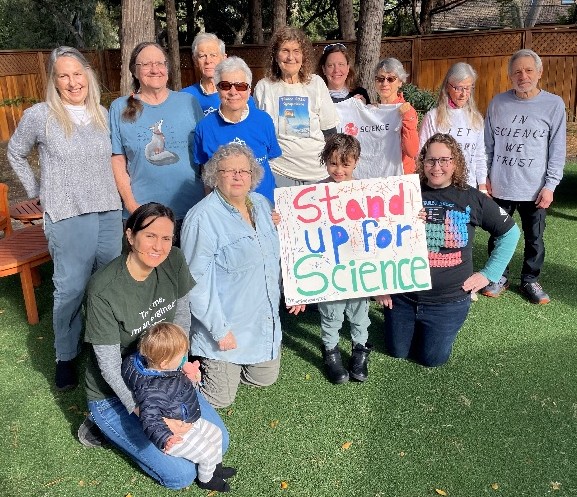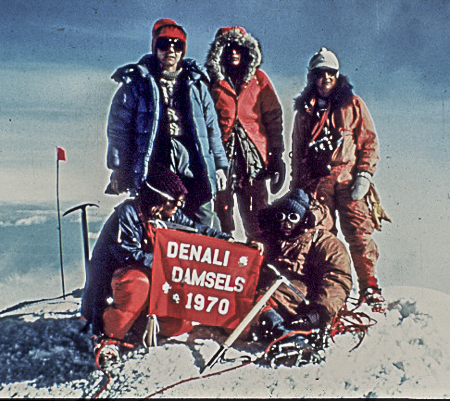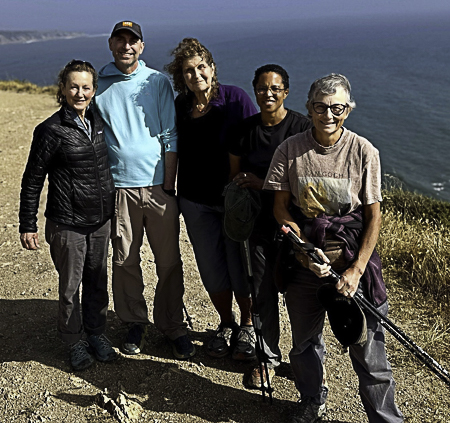June 2025 Newsletter: Peaks, Protests, and Progress
Hello!
| I hope you are enjoying the beginning of summer. I have just returned from an inspiring retreat in beautiful Bolinas in California by the sea with our Institute’s inaugural Senior Fellows. Read about what they plan to accomplish below.
Do you have plans this Saturday—Flag Day? Might you like to participate in a peaceful demonstration in your area celebrating democracy and rejecting authoritarianism? Organizers expect many millions to participate in over 1,500 cities. Please consider joining me in this peaceful protest. Meanwhile President Trump is having a $45 million military parade in Washington, D.C., on Saturday which is also his birthday. This cost can be contrasted to his administration’s devastating cuts to scientific research and other programs that benefit the health and environment of our country and the world. For more about why you should consider participating, check out this opinion piece or this Paul Krugman article. On a happier note, I am pleased to share with you my video interview in the American Alpine Club (AAC) Legacy Series to “pay tribute to the visionary climbers who made the sport what it is today.” You might also enjoy this online exhibit from the AAC featuring my story, gear, and photographs from our 1970 first women’s ascent of Alaska’s Denali as recounted in my memoir Breaking Trail: A Climbing Life. During my AAC interview I recounted some mountaineering stories and their overlap The same flame retardants my research helped remove from kids’ pajamas in 1976 while I was climbing Mt. Everest during the American Bicentennial Expedition are now in our cars—with no demonstrated fire safety benefit. Our Institute is collaborating with Consumer Reports and the International Association of Firefighters to change a 1970 flammability standard. Due to this standard, our study found cancer-causing flame retardants in all 101 cars from 22 brands that we tested! Flame retardants are also being detected in children’s mattresses, as reported in our recent joint study with the University of Toronto. Read more about it in my newest Forbes article. The UK’s mattress trade association reacted to the study by issuing guidance for its members, and a leading US foam certification body has reached out to the paper’s authors to discuss how manufacturers can best test for and eliminate harmful chemicals in their supply chains. We are delighted that our study is prompting movement to children’s mattresses without these problematic chemicals. Finally, here are two videos about PFAS I enjoyed. “How One Company Secretly Poisoned The Planet” and “A Little Story About Forever.” And a last note: We will be having a farewell to our North Berkeley office gathering on Saturday afternoon, June 28. Please write me for an invitation if you’d like to join us to share food, drink, and conversation as well as possibly take home a desk, chair, a very large video screen, or other free office items. Happy summer, P.S. There is an opening for one or two people on a snorkeling and/or scuba adventure trip to explore the rich undersea reefs of Alor Indonesia July 1-11, 2026. Please get in touch ASAP if you might like to join me and my friends. |
Institute Senior Fellows RetreatDuring our first retreat in Bolinas, California, our Senior Fellows identified opportunities to collaborate, support, and complement each other’s work and enjoyed reading, thinking, bird watching, and walking, all in a beautiful setting. Meredith Williams is working to find integrative approaches to addressing plastics, petrochemicals, toxics, and climate. |
We All Scream for SunscreenWith summer just beginning, we are looking for effective sunscreens that do not contain harmful ingredients. This is a challenging topic.  Selecting sunscreens is not so easy Here’s some helpful advice from Marty Mulvihill of Safer Made and our Institute’s Advisory Board: “The FDA recommends mineral sunscreens as a safer choice. They state that the only safe and effective sunscreen ingredients that meet their criteria are zinc oxide and titanium dioxide. These mineral ingredients are also the only ones considered “Reef Safe.” See the Safer Made chapter on UV Filter ingredients. Some brand recommendations: “All Good and Badger are among the best.” People can also use the free Clearya mobile app as described below to select better
Surfrider, a nonprofit focused on healthy reefs and oceans, makes the following recommendations: 1. Check the label. Make sure your sunscreen does not contain the following harmful substances on the HEL list: Oxybenzone, Octinoxate, Octocrylene, 4- A friend who leads the Surfrider Foundation in Kauai, Hawaii, shared her strategy: “I am concerned about the ingredients in sunscreens so I usually wear big hats and long sleeved shirts and stay out of the midday sun.” |
Peregrine Falcons Expose Lasting Harms of Flame Retardant UsePeregrine falcon populations across North America are heavily contaminated with harmful flame retardants–including those that have been phased out for years–according to a new study published in Environmental Science & Technology. Researchers measured concentrations of a suite of old and newer halogenated flame retardants in peregrine falcon eggs collected from multiple locations in the U.S. and Canada between 1984 and 2016. It is the largest investigation to date of flame retardants in peregrine falcons in terms of both time and space. In these falcons, polybrominated diphenyl ethers (PBDEs) were the most commonly detected flame retardants and had the highest concentrations. Despite the fact that production of the major PentaBDE and DecaBDE mixtures ceased in North America by the end of 2004 and 2013, respectively, PBDE concentrations did not decline over the study period in most regions. Similarly, although hexabromocyclododecane (HBCDD) has been phased out from the North American market since 2012, it was detected in the majority of eggs and concentrations did not decrease over the study period in any of the regions. Continued exposure to old flame retardants comes from the release of these chemicals from in-use and discarded products produced before the phase-outs. Further, many flame retardants released from products accumulate up marine and terrestrial food chains over time, making apex predators like peregrine falcons more likely to build up high concentrations in their tissues. Bird flu is also contributing to the recent decline in peregrine falcons. Coastal falcons hunting waterfowl (which can carry bird flu) are the most vulnerable. Peregrine falcons are not the only species harmed by flame retardants. Our “Flame Retardants in Wildlife” map shows more than 150 species of wild animals contaminated with flame-retardant chemicals. Polluted wildlife includes killer whales, red pandas, chimpanzees and other endangered species. |
Dirty Chemicals Don’t Belong in Clean Energy Solutionsby Rebecca Fuoco Lithium-ion batteries are a key part of our growing clean energy infrastructure, with uses in electric cars and electronics (e.g., cell phones, medical devices, smart watches, or laptops). Demand is anticipated to grow exponentially over the next decade. Unfortunately, PFAS are widely used in these batteries, and a new peer-reviewed study has confirmed that this is leading to significant air and water pollution. The authors further found that novel PFAS, called bis-perfluoroalkyl sulfonimides (bis-FASIs), demonstrate environmental persistence and ecotoxicity comparable to notorious phased out compounds such as PFOA. Another study just published identified 25 different PFAS around a lithium-ion battery recycling facility. With PFAS in batteries escaping into the environment from the beginning to the end of their lifecycles, increased attention to chemical usage is needed for a safe clean energy transition. We encourage companies to develop batteries and other clean energy solutions without PFAS or other harmful chemicals (and congratulate the start-ups who are already doing so!) |
Want to Go Trekking in Nepal? Time for a trek? I met Chandra in 2000 when my daughter was attending Lincoln school in Kathmandu and he took her 8th grade class trekking. Since then, I’ve enjoyed a dozen trekking adventures in Nepal under his leadership. Chandra’s company has excellent trips with great food, gear, and guides. He provides personalized itineraries and attention for individual travelers, small and large groups for reasonable prices. To plan a trip customized to your interests, abilities, and timing you can contact Chandra at himtrekzone@gmail.com. Please email me if you have questions. |
Arlene and the Green Science Policy Institute in the Newsby Rebecca Fuoco Below are recent news articles, blogs, podcasts, newsletters, and more that have featured our Institute’s work and expertise.
|





